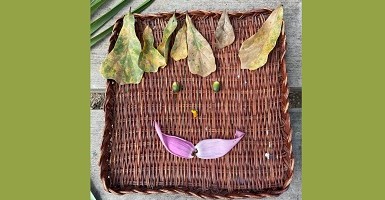March 17, 2022 / News & Blog

| This article is part of the “Children’s Museums and Climate Change” issue of Hand to Hand. Click here to read other articles in the issue. |
By Rachel Daigre, Cate Heroman, and Alexandra Pearson, Knock Knock Children’s Museum
In 2019, MakerEd, a nonprofit organization that brings maker education to communities, selected Knock Knock Children’s Museum to be a regional hub for Making Spaces, a two-year professional learning and capacity-building program designed to support local leadership around maker education, with an emphasis on sustainability and growth. Knock Knock then selected program participants, including fifty preK-third grade educators and administrators from eight elementary schools as well as staff from the nearby public library.
After Hurricane Ida passed through our region in August 2021, Knock Knock provided resources and guidance to help children cope after this natural disaster. To extend our reach, we decided to use our October Making Spaces training as an opportunity to help educators create supportive learning environments in response to severe weather events. We brainstormed how we might use making and tinkering experiences to accomplish two goals: 1) support the emotional needs of children during traumatic events and 2) help deepen their knowledge and understanding of weather-related events in our community.
To reach the first goal, we wanted to inspire teachers to create environments and provide experiences to help children:
To achieve the second goal, we talked about all the things that children might experience during hurricanes: strong winds, power outages, downed trees, flooding, community helpers, lost or destroyed toys, lost pets, gas shortages, long lines, no electronic games to play, giving/receiving donations, damaged buildings, evacuating, relocating, and more.
With these two goals in mind, we set up activities throughout the museum that educators could explore and later implement in their classrooms. The public library assisted by sharing children’s books—both fiction and nonfiction—to support children’s understanding of this weather disaster and to help them cope with their feelings. Teachers quickly realized how they could use the making and tinkering experiences listed below to help children recover from the effects of severe weather events:
Big Backyard: creating weavings and faces with items from nature;
Maker Shop: creating homemade circuit switches in a homemade neighborhood that could be broken by tree limbs, making battery-operated fans and flashlights, making whirligigs powered by wind;
Art Garden: creating miniature Zen gardens, making string art by hammering nails and wrapping them with string, wrapping sticks with yarn to make patterns;
By-You Building: exploring wind at the wind tunnel, building strong houses and water bottle forts;
Paws & Claws: designing and building pet carriers, creating lost pet posters;
Geaux Figure! Playhouse: creating homemade board games;
Go Go Garage: using a homemade grappler tool and working as a team to move roadblocks and ease traffic on the racetrack, playing with model bucket trucks;
Bubble Playground: making floating boats, discovering items that sink or float;
Story Tree: exploring books related to hurricanes as well as supporting the emotional needs of children.
After an hour of exploration, the educators met by grade levels to reflect on these questions:
With the increasing occurrence of hurricanes and floods, children in our community are experiencing phenomena that are difficult to comprehend. Planning new ways to help them and their families understand and rebound after disasters is critical. Making Spaces teachers walked away with making and tinkering strategies to use now and in the future to help children cope, deepen their knowledge, and spark their curiosities.
Rachel Daigre is director of learning innovation; Cate Heroman is education committee chair; and Alexandra Pearson is Maker Shop manager at Knock Knock Children’s Museum in Baton Rouge, Louisiana.